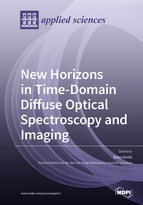New Horizons in Time-Domain Diffuse Optical Spectroscopy and Imaging
A special issue of Applied Sciences (ISSN 2076-3417). This special issue belongs to the section "Optics and Lasers".
Deadline for manuscript submissions: closed (30 September 2019) | Viewed by 55117
Special Issue Editor
Interests: diffuse optics; time-resolved spectroscopy; pediatric neurology; cognitive neuroscience; oxygen metabolism
Special Issues, Collections and Topics in MDPI journals
Special Issue Information
Dear Colleagues,
In 1977, Jöbsis first described the in vivo application of near-infrared spectroscopy (NIRS), which is also called diffuse optical spectroscopy. NIRS was originally designed for clinical monitoring of tissue oxygenation, and it has also become a useful tool for neuroimaging studies (functional near-infrared spectroscopy, fNIRS). A wide range of NIRS instruments have been developed, including commonly commercially available instruments for continuous wave (CW) measurement based on the modified Beer–Lambert law (steady-state domain measurement). During the past 40 years, difficulties in selective and quantitative measurements of tissue hemoglobin have been central issues in the NIRS field. To overcome the problems with quantification, time-domain (TD) and frequency-domain (FD) measurements have been developed. TD measurement is the most promising approach, whereas compared with CW and FD measurements, TD measurement has been less frequently used due to large and expensive instruments with poor temporal resolution and limited dynamic range. Recently, however, the technology has advanced, and TD measurement is now increasingly implemented in research and practice in various clinical settings. This upcoming Special Issue aims to demonstrate the cutting edge of TD diffuse optical spectroscopy and imaging. It covers all aspects of TD measurement, including advances in hardware and instrumentation, methodology, theory of light propagation, and practical implementation.
Prof. Dr. Yoko Hoshi
Guest Editor
Manuscript Submission Information
Manuscripts should be submitted online at www.mdpi.com by registering and logging in to this website. Once you are registered, click here to go to the submission form. Manuscripts can be submitted until the deadline. All submissions that pass pre-check are peer-reviewed. Accepted papers will be published continuously in the journal (as soon as accepted) and will be listed together on the special issue website. Research articles, review articles as well as short communications are invited. For planned papers, a title and short abstract (about 100 words) can be sent to the Editorial Office for announcement on this website.
Submitted manuscripts should not have been published previously, nor be under consideration for publication elsewhere (except conference proceedings papers). All manuscripts are thoroughly refereed through a single-blind peer-review process. A guide for authors and other relevant information for submission of manuscripts is available on the Instructions for Authors page. Applied Sciences is an international peer-reviewed open access semimonthly journal published by MDPI.
Please visit the Instructions for Authors page before submitting a manuscript. The Article Processing Charge (APC) for publication in this open access journal is 2400 CHF (Swiss Francs). Submitted papers should be well formatted and use good English. Authors may use MDPI's English editing service prior to publication or during author revisions.
Keywords
- time-domain diffuse optical spectroscopy
- time-domain diffuse optical imaging
- time-domain fluorescence imaging
- optical properties of biological tissue
- quantification
- time-domain radiative transfer equation
- time-domain photon diffusion equation






